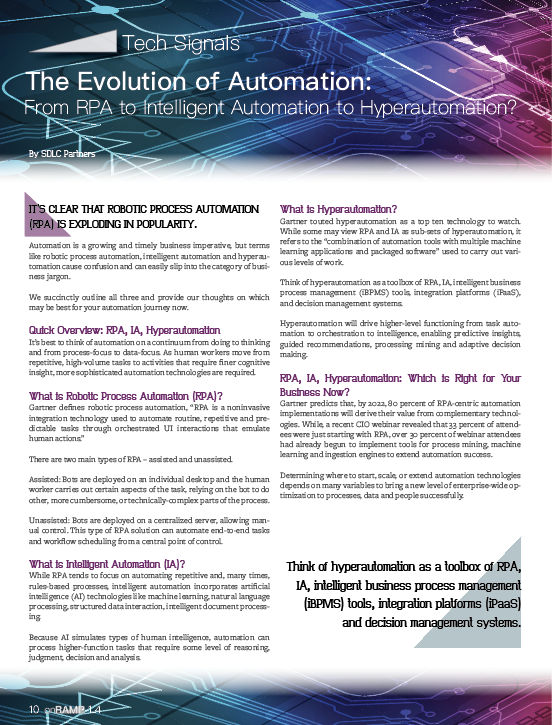The Evolution of Automation: From RPA to Intelligent Automation to Hyperautomation?
SDLC Partners
 It’s clear that Robotic Process Automation (RPA) is exploding in popularity.
It’s clear that Robotic Process Automation (RPA) is exploding in popularity.
Automation is a growing and timely business imperative, but terms like robotic process automation, intelligent automation and hyperautomation cause confusion and can easily slip into the category of business jargon.
We succinctly outline all three and provide our thoughts on which may be best for your automation journey now.
Quick Overview: RPA, IA, Hyperautomation
It’s best to think of automation on a continuum from doing to thinking and from process-focus to data-focus. As human workers move from repetitive, high-volume tasks to activities that require finer cognitive insight, more sophisticated automation technologies are required.
What is Robotic Process Automation (RPA)?
Gartner defines robotic process automation, “RPA is a noninvasive
integration technology used to automate routine, repetitive and predictable tasks through orchestrated UI interactions that emulate
human actions.”
There are two main types of RPA – assisted and unassisted.
Assisted: Bots are deployed on an individual desktop and the human worker carries out certain aspects of the task, relying on the bot to do other, more cumbersome, or technically-complex parts of the process.
Unassisted: Bots are deployed on a centralized server, allowing manual control. This type of RPA solution can automate end-to-end tasks and workflow scheduling from a central point of control.
What is Intelligent Automation (IA)?
While RPA tends to focus on automating repetitive and, many times, rules-based processes, intelligent automation incorporates artificial intelligence (AI) technologies like machine learning, natural language processing, structured data interaction, intelligent document processing.
Because AI simulates types of human intelligence, automation can process higher-function tasks that require some level of reasoning, judgment, decision and analysis.
What is Hyperautomation?
Gartner touted hyperautomation as a top ten technology to watch. While some may view RPA and IA as sub-sets of hyperautomation, it refers to the “combination of automation tools with multiple machine learning applications and packaged software” used to carry out various levels of work.
Think of hyperautomation as a toolbox of RPA, IA, intelligent business process management (iBPMS) tools, integration platforms (iPaaS), and decision management systems.
Hyperautomation will drive higher-level functioning from task automation to orchestration to intelligence, enabling predictive insights, guided recommendations, processing mining and adaptive decision making.
RPA, IA, Hyperautomation: Which is Right for Your Business Now?
Gartner predicts that, by 2022, 80 percent of RPA-centric automation implementations will derive their value from complementary technologies. While, a recent CIO webinar revealed that 33 percent of attendees were just starting with RPA, over 30 percent of webinar attendees had already begun to implement tools for process mining, machine learning and ingestion engines to extend automation success.
Determining where to start, scale, or extend automation technologies depends on many variables to bring a new level of enterprise-wide optimization to processes, data and people successfully.